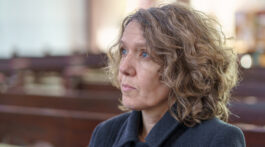After our brief detour into the authority question, I’m back to the issue of why I believe the Bible is the Word of God.
I find it interesting today that so many people judge the God of the Bible as not being good enough. For example, “How can a God who ordered the extermination of the Canaanites be a holy God?” or “How can a God who allowed slavery be a God?” I find these interesting because these critics never examine where their notion that slavery is wrong, or that extermination of even evil people is wrong. I’ve heard them say things like “It’s obvious,” or “It’s self-evident.” These comments demonstrate a near total ignorance of history, philosophy, and religion. The most enelightened of ancient civilizations, for example the Greeks, took slavery for granted. Indeed, they thought it necessary. One could not have the time for refined minds to delve into philosophy, or gifted artists sculpt masterpieces, unless they had slaves to take care of everyday necessities. But we’ll go into that idea in detail later.
The real problem is that they lack awareness of the alternatives. G.K. Chesterton said that when people cease to believe in God, they don’t believe in nothing, they believe in anything.” We see that all around us today. In the ancient world, the world in which the Bible arose, the choices were pretty stark.
Chesterton said that when people cease to believe in God, they don’t believe in nothing, they believe in anything.” We see that all around us today. In the ancient world, the world in which the Bible arose, the choices were pretty stark.
We often hear today that the Bible was not the earliest religious text, and that many parts of the Bible sound similar to other religious texts which preceded it. So that’s where I want to start. What portrait of God do we see in the various traditions.
I’m going to start at the beginning, or, more precisely, “in the beginning.” What God looks like pretty much starts with what the Creator looks like. I’m going to share three basic traditions, because they are representative of nearly all ancient Creation stories. The first type is . . . . creation just sort of happened.
And for that, we’ll start with the Egyptian story. I’m summarizing, because the language can get a little rough.
Only the ocean existed at first. Then Ra (the sun) came out of an egg that appeared on the surface of the water. Ra brought forth four children, the gods Shu and Geb and the goddesses Tefnut and Nut. Shu and Tefnut became the atmosphere. They stood on Geb, who became the earth, and raised up Nut, who became the sky. Ra ruled over all. Geb and Nut later had two sons, Set and Osiris, and two daughters, Isis and Nephthys.
Osiris succeeded Ra as king of the earth, helped by Isis, his sister-wife. Set, however, hated his brother and killed him. Isis then embalmed her husband’s body with the help of the god Anubis, who thus became the god of embalming. The powerful charms of Isis resurrected Osiris, who became king of the netherworld, the land of the dead. Horus, who was the son of Osiris and Isis, later defeated Set in a great battle and became king of the earth.
Notice that “an egg. . . appeared on the surface of the water.” That’s why I say it “just sort of happened.” A battle for control followed, but the creation itself just sort of happened. An egg conveniently appears and the creator emerges. Except. . .where did he come from? When I gave this dialogue in our church, my son said, “This answers the question of which came first, the chicken or the egg!” But of course it doesn’t.
When you look at this story, it’s remarkably like evolution. You have primordial soup, out of which life emerges. That’s one stream of creation stories. Another is the Canaanite. Once again I’m summarizing, because Canaanite language gets really rough.
The council of the gods tests Marduk’s powers by having him make a garment disappear and then reappear. After passing the test, the council enthrones Marduk as high king and commissions him to fight Tiamat. With the authority and power of the council, Marduk assembles his weapons, the four winds as well as the seven winds of destruction.
He rides in his chariot of clouds with the weapons of the storm to confront Tiamat. After entangling her in a net, Marduk unleashes the Evil Wind to inflate Tiamat. When she is incapacitated by the wind, Marduk kills her with an arrow through her heart and takes captive the other gods and monsters who were her allies.
He also captured her husband Kingu. After smashing Tiamat’s head with a club, Marduk divided her corpse, using half to create the earth and the other half to create the sky complete with bars to keep the chaotic waters from escaping
Notice how violent the whole thing is. And by the way, I left out the exceedingly grisly details. This second stream is the creation by violent conflict stream.
Now let’s look at the creation story from the Bible.
- Light
- Waters divided, dry land appears
- Vegetation
- Sun, Moon, Stars – Seasons, Days, Years
- Aquatic animals (lower waters), Birds (firmament-upper waters) populated
- Land Animals, Man – dry land populated
- Rest
By comparison, this an engineering manual. What’s missing compared to the other accounts? Well, first of all, an amazing intelligence goes about a systematic process. It’s far less mystical, in every sense. And no violence whatsoever.
From the standpoint of creation stories, I have to tell you, I find the creator of the Bible far more appealing. No violence, no hocus pocus; system, order, and balance. If there’s a creator at all, it seems to me he/she must be more like the creator of the Bible than either the mystical spontaneous generation god of the Egyptian stream, or the violent and bloodthirsty creator of the Canaanite stream.
The Bible presents a more rational, less mystical, and more benevolent picture of the creator than any other account. That isn’t enough evidence by itself, but there’s yet more. Next time we look at the various accounts of apocalyptic judgment.









